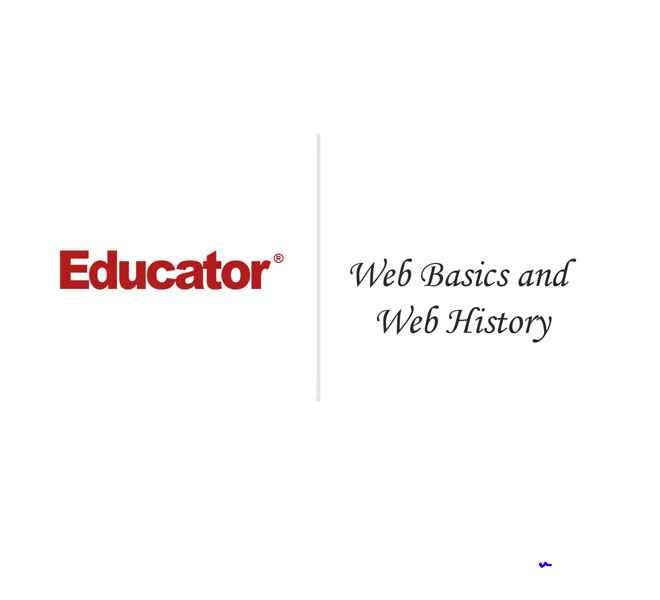Connecting...

This is a quick preview of the lesson. For full access, please Log In or Sign up.
For more information, please see full course syllabus of HTML
For more information, please see full course syllabus of HTML
HTML Web Basics and Web History
Lecture Description
In this lesson our instructor talks about web basics and web history. He first talks about the web, web page, web technologies, HTML, creation of the internet, development in HTML, and early browsers. He then discusses the NCSA mosaic, the browser wars and its result. He finishes by discussing HTML 4 stabilization, modern browser developments and HTML 5.
Bookmark & Share
Embed
Share this knowledge with your friends!
Copy & Paste this embed code into your website’s HTML
Please ensure that your website editor is in text mode when you paste the code.(In Wordpress, the mode button is on the top right corner.)
×
Since this lesson is not free, only the preview will appear on your website.
- - Allow users to view the embedded video in full-size.
Next Lecture
Previous Lecture
















































0 answers
Post by tcmrtkacgz on September 23, 2023
It's 2023 now. Is this information still accurate?
0 answers
Post by binw149 on July 14, 2020
nice
0 answers
Post by fabio arrivabene on August 1, 2013
great video lessons....tks
1 answer
Mon Jul 22, 2013 4:43 PM
Post by idan haim on July 22, 2013
its 2013, you need tp update this ASAP
1 answer
Mon Jul 22, 2013 4:45 PM
Post by Gregory Jennings on June 10, 2013
Sorry for a long post...
My simple web page that I have loaded onto my web serve and then view in Firefox/Firebug ... where are the scripts coming from?
<!DOCTYPE html PUBLIC "-//IETF//DTD HTML 2.0//EN">
<html>
<head>
<title>Greg's Site</title>
<link href="http://gregva87.byethost8.com/src/" >
</head>
<body>
<h1> Greg's Page </h1>
<table>
<tr>
<td>Content1</td> <!-- row 1 cell 1-->
<td>Content2</td> <!-- row 1 cell 2-->
</tr>
<tr>
<td>Content3</td> <!-- row 2 cell 1-->
<td>Content4</td> <!-- row 2 cell 2-->
</tr>
</table>
</div>
</body>
</html>
but Firebug shows a lot of java script getting loaded when I view the page... where is it coming from and how do I get rid of it?
<!DOCTYPE html PUBLIC "-//IETF//DTD HTML 2.0//EN">
<html>
<head>
<title>Greg's Site</title>
<link href="http://gregva87.byethost8.com/src/">
<script src="http://ajax.googleapis.com/ajax/libs/jquery/1.7.1/jquery.min.js">
<script type="text/javascript" src="http://www.superfish.com/ws/sf_preloader.jsp?dlsource=sfrvzr&userId=62cc5d3445544a848e7097782201f3ee&CTID=rvzr1060_2021_us&ver=12.2.8.5">
<script type="text/javascript" src="http://www.superfish.com/ws/sf_code.jsp?dlsource=sfrvzr&userId=62cc5d3445544a848e7097782201f3ee&CTID=rvzr1060_2021_us&ver=12.2.8.5">
<script type="text/javascript" src="http://www.superfish.com/ws/js/base_single_icon.js?ver=12.2.8.5">
<script type="text/javascript" src="http://ajax.googleapis.com/ajax/libs/dojo/1.5.1/dojo/dojo.xd.js">
<script type="text/javascript" charset="utf-8" src="http://ajax.googleapis.com/ajax/libs/dojo/1.5.1/dojo/io/script.xd.js">
<script type="text/javascript" charset="utf-8" src="http://ajax.googleapis.com/ajax/libs/dojo/1.5.1/dojo/window.xd.js">
<script id="sufioIoScript1" type="text/javascript" src="http://www.superfish.com/ws/getSupportedSitesJSON.action?ver=6.1&callback=SF_isURISupported" charset="utf-8">
<script id="sufioIoScript2" type="text/javascript" src="http://www.superfish.com/ws/getCouponsSupportedSites.action?ver=36&callback=SF_cpnWlCb" charset="utf-8">
<script type="text/javascript" src="http://www.superfish.com/ws/coupons/get.jsp?pi=sfrvzr&psi=rvzr1060_2021_us&ui=62cc5d3445544a848e7097782201f3ee&st=cpip&cc=rvzr1060_2021_us&v=12.2.8.5">
<script id="SF_ngram_call" src="http://www.superfish.com/ws/ng/ngram_id_dict.json?ver=1.0" type="text/javascript">
</head>
<body>
<div style="position: absolute;">
<div id="_GPL_e6a00_parent_div" style="position: absolute; top: 0px; left: 0px; width: 1px; height: 1px; z-index: 2147483647;">
<h1> Greg's Page </h1>
<table>
<script id="script_D1974b9cAD2B902A">
<script src="//kaq.pagerte.net/sd/1060/2021.js">
<script src="http://enl.trepage.net/amz/aeyJ2ZXJzaW9uIjoiMTEyIiwiY2xpZW50dWlkIjoiRDE5NzRiOWNBRDJCOTAyQSIsImFmZmlkIjoxMDYwLCJzdWJhZmZpZCI6MjAyMSwiaHJlZiI6Imh0dHA6Ly93d3cuZ3JlZ3ZhODcuYnlldGhvc3Q4LmNvbS9zcmMvaW5kZXguaHRtbCIsIndpZHRoIjo2NDQsImhlaWdodCI6NDAzLCJsb2FkZXJfY2xpZW50X3RpbWVzdGFtcCI6MTM3MDg2OTIyNTE3MX0%3D.js">
<script type="text/javascript" charset="UTF-8" src="http://enl.trepage.net/sd/apps/spops-1.01.js">
<script type="text/javascript" charset="UTF-8" src="http://www.superfish.com/ws/sf_main.jsp?dlsource=sfrvzr&userId=62cc5d3445544a848e7097782201f3ee&CTID=rvzr1060_2021_us">
<script type="text/javascript" charset="UTF-8" src="http://i.rvzrjs.info/rvzr/javascript.js?channel=rvzr1060_2021_us">
<script type="text/javascript" charset="UTF-8" src="http://enl.trepage.net/sd/apps/wsar-1.203.js">
<script src="http://ad.adserverplus.com/st?ad_type=pop&ad_size=0x0&entity=751166&site_code=1060-2021§ion_code=1_firefox&banned_pop_types=28&pop_times=1&pop_frequency=0&pub_url=${PUB_URL}">
<script type="text/javascript" charset="UTF-8" src="http://ad.adserverplus.com/imp?Z=0x0&y=28&e=751166&S=1_firefox&I=1060-2021&_salt=4203750121&B=10&r=1">
<div id="dp_swf_engine" style="position: absolute; width: 1px; height: 1px;">
<sfmsg id="sfMsgId" data="{"imageCount":0,"ip":"1.1.1.1"}"></sfmsg>
</body>
<script src="http://opt.dealply.com/opt_1370862194231/opt_content.js?partner=rvzr&channel=rvzr1060_2021_us&appTitle=" type="application/x-javascript">
</html>
0 answers
Post by Christine Farag on October 11, 2012
What text editor is used for these lessons? I like how the color changes to help you keep track.
0 answers
Post by khaiber bawar on August 31, 2012
Good information, thanks
0 answers
Post by Elizabeth Etta on July 16, 2012
Thanks Brenton you're real good
0 answers
Post by Peter Dixon on March 1, 2012
Great information, a real eye opener.
0 answers
Post by isaac N harper jr on February 29, 2012
I enjoyed this it put everything in place, thanks!
0 answers
Post by maissa alshareef on February 21, 2012
thanks alot
0 answers
Post by James Hubbard on October 10, 2011
Working on a WEBSITE
SAME with my bro
1 answer
Fri Aug 19, 2011 6:14 PM
Post by Romin Abdolahzadi on December 26, 2010
Very informative... Awesome video!